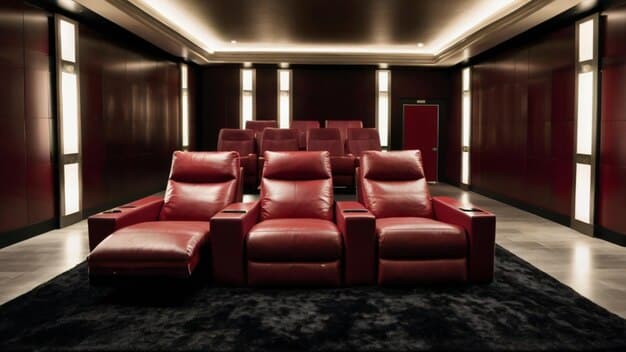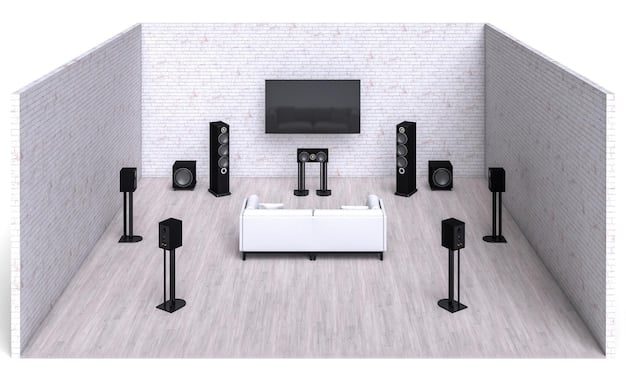Create the Ultimate Home Theater Experience: A Movie Lover’s Guide

Creating your own home theater experience involves careful planning and execution, from selecting the right equipment and optimizing sound and lighting to designing a comfortable and immersive viewing environment, ensuring movie buffs enjoy a cinematic experience at home.
Ready to **create your own home theater experience**? Transform your living room into a cinematic paradise with this comprehensive guide for movie buffs.
Planning Your Home Theater: Setting the Stage
Creating a home theater starts with careful planning. Understanding your space and needs is crucial for designing the perfect cinematic environment. This involves assessing the room, deciding on the screen size, and considering the overall layout to maximize comfort and viewing quality.
Assessing Your Space
The first step is to evaluate the room you’ll be using. Consider the size, shape, and ambient light. A rectangular room often works best, and controlling light is essential for a great picture. Dark walls and ceilings can also enhance the viewing experience by reducing reflections.
Defining Your Needs and Budget
Determine your budget and what features are most important to you. Are you prioritizing picture quality, sound, or seating comfort? Knowing your priorities will help you make informed decisions about equipment and design choices.

Key considerations include:
- Room Size: Match screen size to room dimensions for optimal viewing.
- Seating Arrangement: Plan seating to ensure everyone has a clear view of the screen.
- Acoustics: Consider soundproofing and acoustic treatments to enhance audio quality.
In conclusion, planning the initial setup of your home theater involves a detailed assessment of your space, needs, and budget, ensuring a tailored and immersive cinematic environment.
Choosing the Right Display: Screen Size and Technology
The display is the heart of your home theater. Selecting the right screen size and display technology is critical for achieving the best picture quality. Options include projectors, LED TVs, and OLED TVs, each with its own advantages and considerations.
Projectors vs. TVs: Which is Better?
Projectors offer a large screen experience and are ideal for dedicated home theaters. TVs, especially OLED models, provide excellent contrast and color accuracy, making them suitable for rooms with more ambient light. The choice depends on your room and viewing preferences.
Understanding Resolution and Refresh Rate
Resolution refers to the number of pixels on the screen, with 4K being the current standard for high-definition viewing. Refresh rate measures how many times per second the image is updated, with higher rates providing smoother motion, especially during action scenes.
Key factors to consider:
- Screen Size: Choose a size that fits your viewing distance and room dimensions.
- Resolution: Opt for 4K for sharper and more detailed images.
- Technology: Consider LED, OLED, or projector based on your needs and budget.
In conclusion, selecting the appropriate display involves weighing the pros and cons of projectors versus TVs and understanding the impact of specifications like resolution and refresh rate on your viewing experience.
Immersive Sound: Audio Systems and Speaker Placement
Audio is just as important as video in creating an immersive home theater. Selecting the right audio system and properly positioning your speakers are critical for achieving high-quality sound. Options range from soundbars to multi-channel surround sound systems.

Soundbar vs. Surround Sound System
Soundbars are a convenient and space-saving option, providing improved audio quality over built-in TV speakers. Surround sound systems, with multiple speakers, offer a more immersive and cinematic audio experience.
Optimal Speaker Placement
Proper speaker placement is essential for creating a balanced and immersive soundstage. Front speakers should be placed at ear level, and surround speakers should be positioned around the listening area. A subwoofer adds deep bass for enhanced impact.
Here are some key points:
- Speaker Type: Choose between soundbars or surround sound based on your budget and space.
- Placement: Position speakers strategically for optimal audio quality.
- Calibration: Calibrate your system to balance audio levels and ensure clear sound.
In summary, achieving immersive sound involves selecting the appropriate audio system, strategically placing speakers around the room, and calibrating the system for optimal performance.
Seating and Comfort: Creating a Relaxing Environment
Comfortable seating is an essential component of any home theater. Choosing the right seating arrangement and furniture can greatly enhance your viewing experience. Consider factors like reclining options, material, and overall comfort.
Choosing the Right Seating Arrangement
Consider the number of people who will typically be watching movies and plan the seating accordingly. Reclining chairs offer maximum comfort, while sofas can provide a more social viewing experience. Ensure everyone has a clear view of the screen.
Enhancing Comfort with Accessories
Add accessories like pillows, blankets, and side tables to create a cozy and relaxing environment. Consider installing dimmable lighting to set the mood and reduce eye strain.
Remember to consider:
- Reclining Options: Reclining chairs provide personalized comfort.
- Material: Choose materials that are comfortable and easy to clean.
- Accessories: Add pillows, blankets, and lighting to enhance the viewing experience.
In essence, creating a relaxing environment involves selecting comfortable seating, arranging it strategically, and adding accessories that enhance the overall comfort and viewing experience.
Lighting and Ambiance: Setting the Mood
Lighting plays a crucial role in setting the mood for your home theater. Controlling ambient light and choosing appropriate lighting options can greatly improve the viewing experience. Dimming lights, blackout curtains, and bias lighting are all valuable tools.
Controlling Ambient Light
Minimize ambient light by using blackout curtains or blinds. This will help improve the contrast and clarity of the picture. Dark walls and ceilings can also reduce reflections and enhance the overall viewing experience.
Choosing the Right Lighting Options
Install dimmable lights to adjust the brightness levels according to your preferences. Bias lighting, which places a light source behind the TV, can reduce eye strain and improve perceived contrast.
Some tips include:
- Blackout Curtains: Block out external light for optimal viewing conditions.
- Dimmable Lights: Adjust brightness levels to suit your preferences.
- Bias Lighting: Reduce eye strain and improve perceived contrast.
In summary, setting the mood for your home theater involves controlling ambient light, choosing appropriate lighting options, and creating an environment that enhances the overall viewing experience.
Acoustic Treatments: Optimizing Sound Quality
Acoustic treatments are essential for optimizing the sound quality in your home theater. These treatments help to reduce reflections, absorb sound, and create a more balanced audio environment. Panels, bass traps, and diffusers are commonly used.
Understanding Acoustic Panels
Acoustic panels are designed to absorb sound and reduce reflections, which can improve clarity and reduce echoes. They are typically placed on walls and ceilings to minimize unwanted sound reflections.
Using Bass Traps and Diffusers
Bass traps are designed to absorb low-frequency sounds, while diffusers scatter sound waves to create a more balanced and natural audio environment. These treatments are particularly useful in improving the overall sound quality.
Key considerations:
- Acoustic Panels: Reduce reflections and improve clarity.
- Bass Traps: Absorb low-frequency sounds.
- Diffusers: Scatter sound waves for a balanced audio environment.
In conclusion, optimizing sound quality involves understanding and implementing acoustic treatments to minimize reflections, absorb sound, and create a balanced audio environment.
| Key Point | Brief Description |
|---|---|
| 🎬 Planning Stage | Assess space, define needs, set budget for optimal layout. |
| 🔊 Sound System | Choose soundbar or surround sound, calibrate for clear audio. |
| 🛋️ Seating Comfort | Arrange reclining chairs, add pillows for a cozy environment. |
| 💡 Lighting | Use blackout curtains and dimmable lights to enhance mood. |
FAQ Section
▼
The ideal screen size depends on your viewing distance and room dimensions. Generally, the screen should be large enough to fill your field of vision without causing eye strain. Measure your space for best results.
▼
Projectors are great for large screen experiences in dedicated theaters. TVs, especially OLED, offer better contrast and color in brighter rooms. Consider room conditions and personal preferences when deciding.
▼
Speaker placement is crucial for an immersive audio experience. Front speakers should be at ear level, and surround speakers positioned around the listening area. Proper placement ensures balanced and clear sound from all directions.
▼
Acoustic panels absorb sound and reduce reflections, improving clarity and reducing echoes. They are typically installed on walls and ceilings to minimize unwanted sound interactions, creating a balanced audio environment.
▼
Use blackout curtains or blinds to minimize external light. Dark walls and ceilings can also reduce reflections, enhancing picture contrast. Controlling ambient light is vital for optimal viewing conditions in your home theater.
Conclusion
Creating your own home theater is an exciting project that enhances your movie-watching experience. By carefully planning your space, selecting the right equipment, and optimizing sound and lighting, you can transform any room into a cinematic paradise. Enjoy the show!





